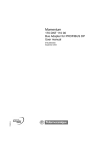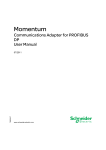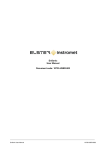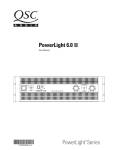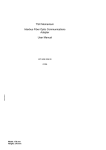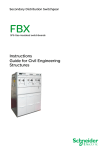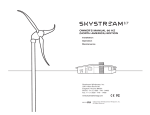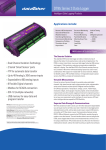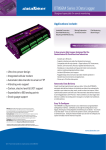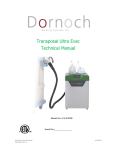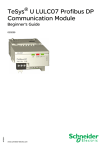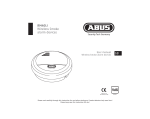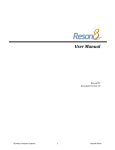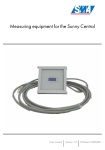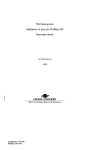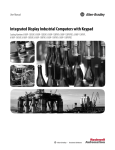Download Modicon TSX Momentum Interbus Communication Adapter User
Transcript
Modicon TSX Momentum Interbus Communication Adapter User Guide 870 USE 003 00 709606.21 10/97 Breite: 178 mm Höhe: 216 mm Data, Illustrations, Alterations Data and illustrations are not binding. We reserve the right to alter products in line with our policy of continuous product development. If you have any suggestions for improvements or amendments or have found errors in this publication, please notify us using the form on one of the last pages of this publication. Training Schneider Automation GmbH offers suitable further training on the system. Hotline See addresses for the Technical Support Centers at the end of this publication. Trademarks All terms used in this publication to denote Schneider Automation GmbH products are trademarks of Schneider Automation GmbH. All other terms used in this publication to denote products may be registered trademarks and/or trademarks of the corresponding Corporations. Microsoft and MS-DOS are registered trademarks of Microsoft Corporation, Windows is a brandname of Microsoft Corporation in the USA and other countries. IBM is a registered trademark of International Business Machines Corporation. Intel is a registered trademark of the Intel Corporation. Copyright All rights are reserved. No part of this document may be reproduced or transmitted in any form or by any means, electronic or mechanical, including copying, processing or by online file transfer, without permission in writing by Schneider Automation GmbH. You are not authorized to translate this document into any other language. 1997 Schneider Automation GmbH. All rights reserved. Content Content Preface . . . . . . . . . . . . . . . . . . . . . . . . . . . . . . . . . . . . . . . . . . . . . . . . . . . . . . . . . . . . 1 Terminology . . . . . . . . . . . . . . . . . . . . . . . . . . . . . . . . . . . . . . . . . . . . . . . . . . . . . . . . . . . . 2 Related Documents . . . . . . . . . . . . . . . . . . . . . . . . . . . . . . . . . . . . . . . . . . . . . . . . . . . . . 3 Chapter 1 Interbus with TSX Momentum Overview . . . . . . . . . . . . . . . . . . . 5 1.1 1.2 1.2.1 1.2.2 1.2.3 1.2.4 1.2.5 1.2.6 1.3 1.4 General Information on Interbus . . . . . . . . . . . . . . . . . . . . . . . . . . . . . . . . . . . . . . . . . . 6 General Information on the 170 INT 110 00 Communications Adapter . . . . . . . . . 7 Compatibility . . . . . . . . . . . . . . . . . . . . . . . . . . . . . . . . . . . . . . . . . . . . . . . . . . . . . . . . . . . 7 Environmental Specification . . . . . . . . . . . . . . . . . . . . . . . . . . . . . . . . . . . . . . . . . . . . . . 8 Physical Structure . . . . . . . . . . . . . . . . . . . . . . . . . . . . . . . . . . . . . . . . . . . . . . . . . . . . . . 8 Function . . . . . . . . . . . . . . . . . . . . . . . . . . . . . . . . . . . . . . . . . . . . . . . . . . . . . . . . . . . . . . . 8 Error Control . . . . . . . . . . . . . . . . . . . . . . . . . . . . . . . . . . . . . . . . . . . . . . . . . . . . . . . . . . . 8 Isolation . . . . . . . . . . . . . . . . . . . . . . . . . . . . . . . . . . . . . . . . . . . . . . . . . . . . . . . . . . . . . . . 9 Interbus Configuration with TSX Momentum . . . . . . . . . . . . . . . . . . . . . . . . . . . . . . 10 Configuration Limits . . . . . . . . . . . . . . . . . . . . . . . . . . . . . . . . . . . . . . . . . . . . . . . . . . . . 12 Chapter 2 Communications Adapter Register Mapping . . . . . . . . . . . . . . 13 2.1 2.2 2.2.1 2.2.2 I/O words and ID–code . . . . . . . . . . . . . . . . . . . . . . . . . . . . . . . . . . . . . . . . . . . . . . . . . 14 Mapping Data Bits to I/O Base Terminals . . . . . . . . . . . . . . . . . . . . . . . . . . . . . . . . . 16 Data Register Mapping for Discrete I/O bases . . . . . . . . . . . . . . . . . . . . . . . . . . . . . 16 Data Register Mapping for Analog I/O bases . . . . . . . . . . . . . . . . . . . . . . . . . . . . . . 17 Chapter 3 Module Description of 170 INT 110 00 . . . . . . . . . . . . . . . . . . . . . 19 3.1 3.2 3.3 3.4 Communication Adapter Overview . . . . . . . . . . . . . . . . . . . . . . . . . . . . . . . . . . . . . . . 20 Preparing the Remote Bus Cable . . . . . . . . . . . . . . . . . . . . . . . . . . . . . . . . . . . . . . . . 21 LED Status Displays . . . . . . . . . . . . . . . . . . . . . . . . . . . . . . . . . . . . . . . . . . . . . . . . . . . 24 Technical Specifications . . . . . . . . . . . . . . . . . . . . . . . . . . . . . . . . . . . . . . . . . . . . . . . . 25 Appendix . . . . . . . . . . . . . . . . . . . . . . . . . . . . . . . . . . . . . . . . . . . . . . . . . . . . . . . . . 27 Appendix A EMC Measures for the Communications Adapter . . . . . . . . . . 29 A.1 Overvoltage Protection for Remote Bus Lines (lightning protection) . . . . . . . . . . 30 III Breite: 178 mm Höhe: 216 mm Content IV Info.50 Preface Caution The relevant regulations must be observed for control applicatons involving safety requirements. For reasons of safety and to ensure compliance with documented system data, repairs to components should be performed only by the manufacturer. 1 Breite: 178 mm Höhe: 216 mm Preface Terminology Note This symbol emphasizes very important facts. Caution This symbol refers to frequently appearing error sources. STOP Warning This symbol points to sources of danger that may cause financial and health damages or may have other aggravating consequences. Expert This symbol is used when a more detailed information is given, which is intended exclusively for experts (special training required). Skipping this information does not interfere with understanding the publication and does not restrict standard application of the product. Tip This symbol is used for Tips & Tricks. Example This symbol emphasizes the begining of an example. Figures are annotated in the spelling corresponding to international practice and approved by SI (Systéme International d’ Unités). The notation applied to numerical values conforms to international practice, as well as a SI (Système International d’ Unités) sanctioned representation. This notational format requires a space between hundreds and thousands, and the use of the decimal point (For example: 12 345.67). 2 Preface Related Documents Title I/O Module Bases for TSX Momentum, User Manual Modicon Terminal Block I/O Modules Hardware Reference Guide Order–No. 870 USE 002 00 890 USE 104 00 3 Breite: 178 mm Höhe: 216 mm Preface 4 Interbus with TSX Momentum Overview 1 The following topics will be reviewed in this chapter: H H H H General information on Interbus General information on the 170 INT 110 00 communication adapter Interbus Configuration with TSX Momentum Configuration limits 5 Width: 178 mm Height: 216 mm Interbus with TSX Momentum Overview 1.1 General Information on Interbus Interbus is an open communications standard currently supported by over 200 equipment manufacturers with many diverse products. Interbus is a high speed network design to connect I/O Modules, sensors, actuators and control devices with programmable controllers and computer systems. Interbus is a master/slave network designed for the efficient exchange of I/O data. It has the capability to communicate with up to 256 devices over a distance of 42,000 feet (13 km) using twisted pair cable, and read 1024 inputs and write 1024 outputs in 4 ms. This provides optimum flexibility in configuration of a control system in terms of the number of I/O drops and communication distances. In addition to system configuration flexibility, Interbus does not compromise system performance or reliability of I/O data. In addition to the Modicon Terminal I/O modules, the use of Interbus compatible control products from other manufacture’s provides an easy to integrate, cost effective control system based on an open system architecture. A typical system configuration using Terminalblock I/O Modules together with Momentum I/O modules is shown in Figure 2 (page 11). The 170 INT 110 00 Interbus Communication Adapter provides the communication interface between Momentum I/O base and the Interbus network. This adapter can be plugged into any Momentum I/O base to create a functional I/O unit on the Interbus network. 6 Interbus with TSX Momentum Overview 1.2 General Information on the 170 INT 110 00 Communications Adapter 1.2.1 Compatibility The Interbus communication adapter is compatible with all Momentum I/O bases. It plugs into any I/O base to form a functional I/O unit communicating on the Interbus network. The TSX Momentum I/O modules are designed for connection only to the remote bus of the Interbus network. Figure 1 Front view of a TSX Momentum I/O base and Interbus Communication Adapter attached Communications Adapter 170 INT 110 00 I/O base TSX Momentum I/O modules operate with every Interbus Master Module which has the Interbus certification. The 170 INT 110 00 Communications Adapter does not support the PCP protocol. 7 Width: 178 mm Height: 216 mm Interbus with TSX Momentum Overview 1.2.2 Environmental Specification The adapter conforms to the environmental specification of the I/O base upon which it is installed. For environmental specification refer to the TSX Momentum I/O bases user manual 870 USE 002 00. 1.2.3 Physical Structure The communication adapter (safety type IP20) is attached to the I/O base making a connection. Snap–on tabs lock the adapter in place. The adapter can be released with a screwdriver. With the I/O base there is a label shipped. It fits into an area on the front side of the adapter. In this label, you can write the signal names corresponding to the wired field devices. On the right side of this label, there is a clear window to identify the type of the Communication Adapter. 1.2.4 Function The communication adapter has two ports (an incoming remote bus and an outgoing remote bus) implemented as RS 485 interfaces. The incoming remote bus is isolated. The interfaces meet Interbus standards (DIN 19258). Each node regenerates the entire message stream before passing it on the next node. As each node handles the message stream, it extracts the portion of the message that is assigned to that node as input data (into the node), and adds output data (from the node) to the message stream as applicable to that type of node device. 1.2.5 Error Control The internal voltage supply (Vcc) is provided by the I/O base. Vcc is monitored and a Reset signal is generated if and when Vcc is not within tolerance. The isolated voltage (Vcx) for the Interbus interface is generated via a DC/DC converter and is not controlled. A Serial Microprocessor Interface controls three display LEDs which indicate the data transfer (Bus Aktiv, Remote Bus Check, Remote Bus Disabled – refer to ”LED Status Displays” page 24). The internal Watchdog timer is 640 ms and when expires the LED ”Bus enabled”, is lightened. When an I/O base signals an I/O–Error, that signal is transmitted to the bus master via Interbus as a module error. 8 Interbus with TSX Momentum Overview 1.2.6 Isolation The picture shows potential isolation/nonisolation between two I/O modules. Areas with the same grey color have the same reference potential. ÉÉÉÉÉÉÉÉÉÉÉÉÉÉÉ ÉÉÉÉÉÉÉÉÉÉÉÉÉÉÉ ÉÉÉÉÉÉÉÉÉÉÉÉÉÉÉ ÉÉÉÉÉÉÉÉÉÉÉÉÉÉÉ ÉÉÉÉÉÉÉÉÉÉÉÉÉÉÉ ÉÉÉÉÉÉÉÉÉÉÉÉÉÉÉ ÉÉÉÉÉÉÉÉÉÉÉÉÉÉÉ ÉÉÉÉÉÉÉÉÉÉÉÉÉÉÉ ÉÉÉÉÉÉÉÉÉÉÉÉÉÉÉ ÉÉÉÉÉÉÉÉÉÉÉÉÉÉÉ ÉÉÉÉÉÉÉÉÉÉÉÉÉÉÉ ÉÉÉÉÉÉÉÉÉÉÉÉÉÉÉ ÉÉÉÉÉÉÉÉÉÉÉÉÉÉÉ ÉÉÉÉÉÉÉÉÉÉÉÉÉÉÉ ÉÉÉÉÉÉÉÉÉÉÉÉÉÉÉ ÉÉÉÉÉÉÉÉÉÉÉÉÉÉÉ ÉÉÉÉÉÉÉÉÉÉÉÉÉÉÉ ÉÉÉÉÉÉÉÉÉÉÉÉÉÉÉ ÉÉÉÉÉÉÉÉÉÉÉÉÉÉÉ ÉÉÉÉÉÉÉÉÉÉÉÉÉÉÉ ÉÉÉÉÉÉÉÉÉÉÉÉÉÉÉ I/O module n INTERBUS DSUB 9–pin IN I/O module n + 1 INTERBUS INTERBUS INTERBUS DSUB 9–pin OUT DSUB 9–pin IN DC/DC Converter DC/DC Converter Vcx Vcx Electronics Vcc GND DSUB 9–pin OUT Electronics Vcc Connector 12–pin Interface I/O base GND Connector 12–pin Interface I/O base 9 Width: 178 mm Height: 216 mm Interbus with TSX Momentum Overview 1.3 Interbus Configuration with TSX Momentum The following is a brief summary of the Interbus topology and configuration: The Interbus serial protocol is implemented as remote and local bus types. Each bus type carries the same signals, but at different electrical levels. Remote Bus The remote bus is used for long distance transfer of data, up to 1 200 feet between 2 nodes. Output from the Bus Master board starts the first remote bus. No power passes through the remote bus cable. Electrical voltage levels are RS–485. Network operates at 500 k baud, full duplex. Typical remote bus nodes are, for instance, Momentum I/O modules, TIO modules or branch interfaces. The sections between two remote bus nodes are referred to as remote bus segments. Remote Bus Branch The remote bus branch is generated by a branch interface (e.g. 170 BNO 671 00). The branch interface module itself is a remote bus node on the Interbus network. The Momentum I/O Modules can directly connect to the remote bus branch as well as to the remote bus. Installation Remote Bus The installation remote bus is generated by specific bus terminal modules. The bus terminal module itself is a remote bus node. The I/O Modules on the installation remote bus are of a special nature, and can only be used on the installation remote bus. Note TSX Momentum I/O modules are designed for connection only to the remote bus and the remote bus branch. They cannot be used on the installation field bus. 10 Interbus with TSX Momentum Overview Figure 2 Example of an Interbus Configuration with Momentum I/O Modules NOA 611 TSX Quantum with Interbus master CPU Remote Bus Branch Interface 170 BNO 671 00 Remote Bus nodes Momentum I/O base with 170 INT 110 00 or Terminal Block I/O Remote Bus Remote Bus nodes Momentum I/O base with 170 INT 110 00 or Terminal Block I/O Remote Bus Branch Nodes on remote bus branch Momentum I/O base with 170 INT 110 00 or Terminal Block I/O 11 Width: 178 mm Height: 216 mm Interbus with TSX Momentum Overview 1.4 Configuration Limits Table 1 Interbus Configuration Limits for Standard PLC (e.g. TSX Quantum) Parameters max. number of nodes (slaves) max. distance between 2 nodes max. distance between 2 nodes max. distance between 2 nodes max. length of network max. number of I/O points Transfer Rate Data throughput for 1 000 I/O points 12 Limitations 256 Twisted pair, shielded = 400 m (1 200 ft) Fiber optic (HCS) = 300 m (900 ft) fiber optic cable, polymer fiber = 50 m (150 ft) 13 km (8 mi) 4096 500 kBits/s ~ 4 ms Communications Adapter Register Mapping 2 The following topics will be reviewed in this chapter: H H I/O words and ID–code Mapping Data Bits to I/O Base Terminals 13 Width: 178 mm Height: 216 mm Communications Adapter Register Mapping 2.1 I/O words and ID–code After the I/O module is powered–up, the identification code (ID code) of the module base is automatically read by the communication adapter. The ID–code provides the Interbus master with the type of data (input or output) and the number of words in the message for each module. After the I/O modules identification codes are received, the Interbus master will automatically begin the execution of I/O data communication in real time. The length is in each case expressed in I– or O–words, with the higher number being the decisive factor. The number of words it can contain is: 1 to 10, 12, 14, 16, 24 or 32 words. Example The ID–code for the 170 ADM 350 10 is 0103 hex. H H 01 = Length statement, indicating that the module needs one word (I– or O–word) for data transfer 03 = Module Type, indicates that this module has inputs and outputs Table 2 14 I/O Base Word Number and ID Code (analog I/O bases) Description 170 AAI 140 00 Function 16 input channels I–Words 16 170 AAI 520 40 4 input channels, RTD, Therm. 4 170 AAO 120 00 4 output channels, 0 ... 20 mA 170 AAO 921 00 4 output channels, 4 ... 20 mA 170 AMM 090 00 4 inputs, 2 outputs (discrete) 4 input & 2 output channels (analog) 1 4 O–Words ID Code 4 1033 hex 1651 dec 4 0433 hex 0451 dec 5 0531 hex 0549 dec 5 0531 hex 0549 dec 1 0533 hex 4 0551 dec Communications Adapter Register Mapping Table 3 I/O Base Word Number and ID Codes (discrete I/O bases) Description 170 ADI 340 00 170 ADI 350 00 170 ADI 540 50 Function 16 inputs 32 inputs 16 inputs I–Words 1 2 1 O–Words 0 0 0 ID Code 0102 0202 0102 170 ADO 340 00 170 ADO 350 00 170 ADO 530 50 170 ADO 540 50 170 ADO 730 50 170 ADO 740 00 16 outputs 32 outputs 8 outputs 16 outputs 8 outputs 16 outputs 0 0 0 0 0 0 1 2 1 1 1 1 0101 0201 0101 0101 0101 0101 170 ADM 350 10 170 ADM 350 11 170 ADM 370 10 170 ADM 390 10 16 inputs, 16 outputs 16 inputs, 16 outputs 16 inputs, 8 outputs 16 inputs, 12 outputs 1 1 1 1 0103 0103 0103 0303 170 ADM 390 30 170 ADM 690 50 10 inputs, 8 outputs 10 inputs, 8 outputs 1 1 1 3 (1 discrete and 2 diagnostics) 1 1 1 1 0103 0103 15 Width: 178 mm Height: 216 mm Communications Adapter Register Mapping 2.2 Mapping Data Bits to I/O Base Terminals 2.2.1 Data Register Mapping for Discrete I/O bases The data transmitted to or from the I/O base are transfered 1 : 1 from/to the communication adapter. Data in controller registers is mapped to the field terminals of discrete I/O bases in the following way: H H H H Mapping is done by words (max. 2 for 32 I’s or O’s). The Most Significant Word (MSW) is always sent or received first. The words sent by the communications adapter to the I/O base represent the outputs (Output–words). The words sent from the I/O base to the communications adapter represent the inputs (Input–words). Data mapping for two discrete I/O bases is shown as an example: Figure 3 I/O Mapping of the 170 ADI 350 00 (32 Inputs) and 170 ADO 350 00 (32 Outputs) Input Data from 170 ADI 350 00 Output Data to 170 ADI 350 00 MSW = Word 2 Inputs 17 ... 32 MSW = Word 2 Outputs 17 ... 32 LSW = Word 1 Inputs 1 ... 16 LSW = Word 1 Outputs 1 ... 16 Additional documentation: Refer to the I/O bases User Manual (870 USE 002 00) for further information. 16 Communications Adapter Register Mapping 2.2.2 Data Register Mapping for Analog I/O bases Data in controller registers is mapped to the field terminals of analog I/O bases in the following way: H H H H Each analog value is mapped to one word. The Most Significant Word (MSW) is sent or received first. The words sent by the communications adapter to the I/O base represent the output values and parameters (Output–words). The words sent from the I/O base to the communications adapter represent the input values and status (Input–words). Data mapping for one analog I/O base is shown as an example: Figure 4 I/O Mapping of the 170 AAI 140 00 (16 Input Channels) e.g. Input Data from 170 AAI 140 00 Output Data to 170 AAI 140 00 MSW = Word 16 Value channel 16 MSW = Word 16 empty Word 15 Value channel 15 Word 15 empty to to Word 5 Value channel 5 Word 5 empty Word 4 Value channel 4 Word 4 Parameters, Channels 13 ... 16 Word 3 Value channel 3 Word 3 Parameters, Channels 9 ... 12 Word 2 Value channel 2 Word 2 Parameters, Channels 5 ... 8 LSW = Word 1 Value channel 1 LSW = Word 1 Parameters, Channels 1 .. 4 Additional documentation: Refer to the I/O bases User Manual (870 USE 002 00) for further information. 17 Width: 178 mm Height: 216 mm Communications Adapter Register Mapping 18 Module Description of 170 INT 110 00 3 The following topics will be reviewed in this chapter: H H H H Communication Adapter Overview Preparing the Remote Bus Cable LED Status Displays Technical Specifications 19 Width: 178 mm Height: 216 mm Module Description of 170 INT 110 00 3.1 Communication Adapter Overview The Interbus Communiation Adapter can be operated with any TSX Momentum I/O base. Table 4 Basic Data Communication Adapter for Interbus,Remote Bus only 5 VDC / 250 mA (from I/O base) 500 K bits/s 400 m, 1200 ft. (single module spacing) up to 13 000 m, 8 mi (total bus length) Module Type Power Supply Transfer Rate Bus length IN (pins) BA OUT (sockets) 1 2 RC RD 3 Module Elements: 1. Interbus connector 2. LED Display 3. Label (shipped with the I/O base) 20 Module Description of 170 INT 110 00 3.2 Preparing the Remote Bus Cable Modules at inline sites on the Interbus remote bus cable will have two connections. One connection is to the incoming bus cable, and the other is to the outgoing bus cable. Modules at end sites on the network cable will have one connection. This is to the incoming bus cable only. You should plan to provide a complete cabling diagram for your network installation, showing the cable routing path and methods of securing the cable. Your diagram should identify incoming and outgoing cables at each module site. Figure 5 Top view of a TSX Momentum I/O Module base and Interbus Communication Adapter attached Rear Panel Incoming bus connector (pins) Front Panel Outgoing bus connector (sockets) Figure 6 Connectors on Interbus Communication Adapter Interbus input (pins) Interbus output (sockets) Pin assigned free 21 Width: 178 mm Height: 216 mm Module Description of 170 INT 110 00 Modicon provides pre-fabricated Interbus cables in four lengths. Each cable has two connectors installed for direct interconnection between two modules. Modicon also provides a connector kit for installation onto user-supplied cable. The kit contains one pin and one socket connector (ordering details see specs). Please note the following general requirements: H The maximum remote–bus cable length is 13 km (8 mi.). The cable length between two remote–bus nodes must not exceed 400 m (1200 ft)! H Ready–made off–the–shelf cables are available for the remote bus: see specs. Custom lengths need to be prepared by the user. H The connectors for the outgoing remote bus are always pins, those for the incoming remote bus are always sockets. H In the outgoing remote bus connector, pins 5 und 9 must be connected (refer to scematic the figure below)! H Connect the cable shield to the connector. H For the remote bus you will need a 5–wire cable, twisted–pair type, shielded; this cable is available by the meter (KAB–3225–LI). Wire the connectors of the remote bus cable as follows: Outgoing Remote Bus (pins) 22 Incoming Remote Bus (sockets) Module Description of 170 INT 110 00 Pin Wire Color 1 yellow 2 grey 3 brown 4 Connectionoutgoing remote bus DO – Data Out DI – Data IN Common GND – Reference conductor, fiber–optic adapter Pin Wire Color 1 yellow 2 grey 3 brown 4 Connectionoutgoing remote bus DO – Data Out DI – Data IN Common* GND* – Reference conductor, fiber–optic adapter 5 Vcc – Power supply for fiber–optic adapter DO_N – Data Out Negated DI_N – Data IN Negated Vcc – Additional power supply for fiber–optic adapter Plug identification 5 Vcc* – Power supply for fiber–optic adapter DO_N – Data Out Negated DI_N – Data IN Negated Vcc* – Additional power supply for fiber–optic adapter not used 6 7 8 9 green pink 6 7 8 9 green pink *) physically isolated 23 Width: 178 mm Height: 216 mm Module Description of 170 INT 110 00 3.3 LED Status Displays BA RC RD Table 5 LED BA RC LED Status Displays Status Green Off Green Off RD 24 Red Off Function Bus enabled. Data messages are being transmitted. No data messages are being transmitted. Remote Bus Check. Incoming remote bus is correctly connected and the Bus Reset of the Busmaster is disabled. Incoming remote bus not connected or incorrectly connected, or Busmaster Bus Reset is enabled. Remote Bus Disabled. Extended remote bus is switched off. Extended remote bus is not switched off. Module Description of 170 INT 110 00 3.4 Technical Specifications General Power consumption Power dissipation Potential Isolation RS 485 (remote bus in) RS 485 (remote bus out) Error Detection Data Exchange Fuses Supply voltage Vcc < 200 mA at 5 V (supplied by I/O base) excluding fiber–optic adapter < 400 mA at 5 V (supplied by I/O base) including two fiber–optic adapters 0.8 W (typ) without fiber–optic adapter isolated from remaining logic no isolation Red LED for bus errors (RD) and error message from I/O unit (module error). Internal (for bus adapter) – None External (for I/O base – as per default by designating the appropriate I/O base Interbus Data Interface Interface Mapping RS 485 Bus Length max. 8 mi. (13 km) over all bus length max. 1 200 ft. (400 m) between 2 modules Option refer to Preparing the Remote Bus Cable Transfer Rate 500 kBits/s 500 kBits/s Fiber–optic Adapter 25 Width: 178 mm Height: 216 mm Module Description of 170 INT 110 00 How to order: Description Interbus Communication Adapter Remote Bus Cable (sold by the meter) Interbus connector set, sockets/pins, 9–pin Interbus Cable, 11 cm (0.36 ft), with small connectors Interbus Cable, 8 cm (0.26 ft) compatible to TIO and Momentum Interbus Cable, 25 cm (0.8 ft) compatible to TIO and branch interface Interbus Cable, 100 cm (3.3 ft) Set of Labels, qu’ty of 10. 26 Part No. 170 INT 110 00 KAB–3225–LI 170 XTS 009 00 170 MCI 007 00 170 MCI 008 00 170 MCI 025 00 170 MCI 100 00 170 XCP 100 00 Appendix 27 Breite: 178 mm Höhe: 216 mm 28 EMC Measures for the Communications Adapter H A Overvoltage Protection for Remote Bus Lines 29 Width: 178 mm Height: 216 mm EMC Measures for the Communications Adapter A.1 Overvoltage Protection for Remote Bus Lines (lightning protection) To protect transmission systems from flash–over voltage surges (e.g. lightning), the remote bus line should be equipped with overvoltage protectors (lightning arrestors) whenever it is installed outside a building. The nominal discharge current should be at least 5 kA, for instance by using a type ARE, Cat. Nr. 919 232 made by Dehn und Söhne, Postfach 1640, 92 306 Neumarkt, Germany or Dehn und Söhne, Hans– Dehn– Str. 1, 92 318 Neumarkt, Germany Protecting a remote bus cable requires three ARE lightning arrestors per building. 30 EMC Measures for the Communications Adapter Figure 7 Circuit layout and dimensions of the ARE lightning arrestor 1 3 2 4 OUT IN 45 90 OUT IN 17.5 5 35 88 31 Width: 178 mm Height: 216 mm EMC Measures for the Communications Adapter Figure 8 Schematic of ARE lightning arrestor connection rd gr gn ye ÒÒ ÒÒ ÒÒ ÒÒ br (GND) Shielding 6 mm 2 Z2 ARE ARE ARE ARE ARE ARE DINTop hat rail Outdoors Protective Ground ye gn gr rd ÒÒ ÒÒ 6 mm 2 Functional Ground Shielding br (GND) W1 Building 1 W1 Z2 ÒÒ ÒÒ Building 2 Remote Bus Line LiYCY (TP) Grounding clamp Make sure to observe the following rules: H H H H H 32 Do not mix the wires as you run them. Do not mismatch the IN- and OUT ends of the ARE (IN = outdoors) Install a functional ground (potential–equalization rod) Install the lightning arrestor near the building ground so as to establish a short discharge path for the surge current. Keep the line to the building and functional ground (at least 6 mm2) as short as possible. In a remote bus line you can connect a maximum of 10 lightning arrestors in series, with five outdoor segments which can interlink up to six buildings.




































